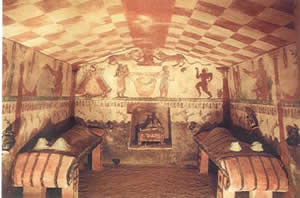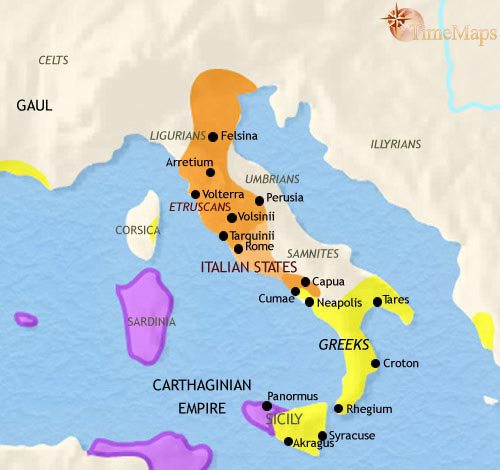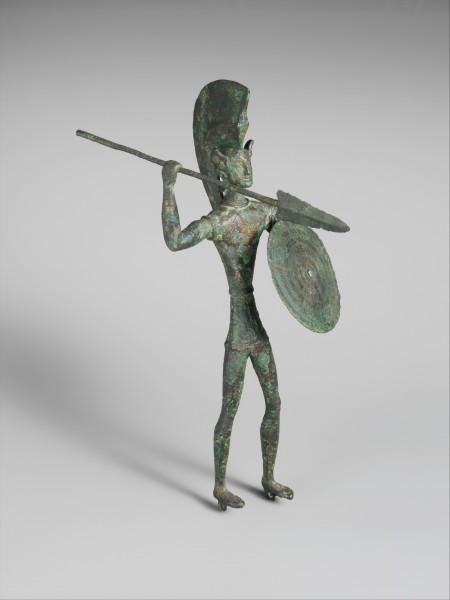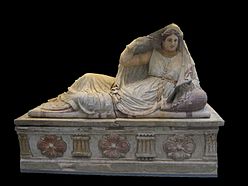The Etruscans: Early Italian Power
One of the main powers in central Italy before the advent of Rome was the Etruscan civilization.
Like the Greeks, the Etruscans had city-states as their main political unit. The Etruscans began with 12 city-states and expanded as their civilization and influence grew. Originally monarchies, the city-states in large part moved to oligarchy, as did the Greeks, although some Etruscan city-states remained ruled by king figures. The city-states together made up the Etruscan League, which served as a unifying device and consisted largely of an annual meeting of representatives of all members.
Etruscan economic exports included iron, pottery, wine, olive oil, and grain. A style of pottery known as Bucchero was especially popular as an export, in shapes including bowls, cups, jobs, and utensils. Bucchero pottery has been found in Etruscan tombs. Etruscans minted their own coins, beginning in the 5th Century B.C. They also had their own language.
Etruscan women had more rights than women in other concurrent civilizations. One prime difference was that Etruscan women could inherit property in their own right. 
Etruscan architecture borrowed from the Greek tradition and predated the Roman tradition. Etruscan temples and tombs are held up as particularly emblematic of famous ancient architecture. Etruscans had to fend off invasions from the north, from Celtic tribes, beginning the 5th Century B.C. However, the Roman civilization to the south eventually became the dominant force in Italy. Rome didn't so much conquer the Etruscans as absorb them and their culture. In several significant ways, Roman culture very much resembles Etruscan culture. The story of Romulus and Remus, the legendary brother founders of Rome, comes from Etruscan tradition, as does a famous sculpture depicting the brothers being nursed by a she-wolf. The Romans also borrowed elements of Etruscan dress and certain other cultural elements, such as a victory procession that predated the Roman triumph, celebrating military victory. |
|



 Etruscans flourished in what was called Etruria beginning about the 8th Century B.C.; their eminence declined sharply in the 3rd and 2nd Centuries B.C., as Rome rose to prominence. That is the tradition adhered to by many historians. It differs from the account of the famed ancient Greek historian
Etruscans flourished in what was called Etruria beginning about the 8th Century B.C.; their eminence declined sharply in the 3rd and 2nd Centuries B.C., as Rome rose to prominence. That is the tradition adhered to by many historians. It differs from the account of the famed ancient Greek historian  From time to time, the Etruscan city-states warred with one another; they also struggled for influence in the Mediterranean area, against Carthaginians, Greeks, and Phoenicians. Etruscan soldiers commonly wore Greek-like breastplates, helmets, and graves and employed a Greek-like phalanx battle formation.
From time to time, the Etruscan city-states warred with one another; they also struggled for influence in the Mediterranean area, against Carthaginians, Greeks, and Phoenicians. Etruscan soldiers commonly wore Greek-like breastplates, helmets, and graves and employed a Greek-like phalanx battle formation. The Etruscans had a common polytheistic religion. The main deity was Tin, the sky god. Etruscan art had a very religious feel at times; also common in their art were musical motifs, including instruments, and other forms of entertainment, such as dancing. Etruscans were accomplished players of stringed instruments like the kithara and the lyre and of various kinds of piped instruments.
The Etruscans had a common polytheistic religion. The main deity was Tin, the sky god. Etruscan art had a very religious feel at times; also common in their art were musical motifs, including instruments, and other forms of entertainment, such as dancing. Etruscans were accomplished players of stringed instruments like the kithara and the lyre and of various kinds of piped instruments.
